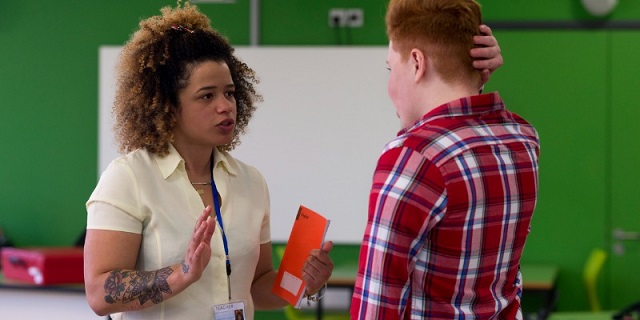Education
School board trustees should embrace genuine diversity and avoid unnecessary legal fights

From the Fraser Institute
Too many Canadian school boards are getting sidetracked by unnecessary legal battles rather than focusing on educating students.
Case in point, Carolyn Burjoski, a former teacher in the Waterloo Region District School Board (WRDSB), recently won a decisive legal victory when Justice James Ramsay rejected WRDSB’s attempt to quash Burjoski’s defamation lawsuit and awarded her $30,000 in legal fees.
Burjoski had sued her former employer because the board chair publicly accused her of transphobic behaviour for raising concerns during a board meeting about the sexualized content in a number of school library books. His public attacks on Burjoski exposed the school board to a defamation lawsuit.
In his decision, Justice Ramsay found that the WRDSB chair “acted with malice or at least a reckless disregard for the truth.” Furthermore, Ramsay explained, nothing Burjoski said during the meeting could reasonably be described as transphobic. Given these facts, it comes as little surprise that the judge ruled decisively in Burjoski’s favour.
Things could have been handled much better by the board. Had the trustees stayed focused on education, they likely would not have gotten sidetracked by Burjoski’s comments. They could have simply thanked Burjoski for her input then gotten back to work on education policy. Instead, the board chair picked a fight with one of his own teachers and led his fellow trustees into a losing legal battle. No one can seriously think this was in the best interest of students, particularly since school taxes were spent on legal fees rather than classroom resources.
Sadly, WRDSB is far from the only school board where trustees are distracted by non-educational issues. In Winnipeg’s Louis Riel School Board, trustee Francine Champagne was suspended three times in one year for making controversial social media posts and failing to submit paperwork. The board even filed a legal application to have Champagne removed from office for allegedly violating the Public Schools Act. However, Champagne resigned before the court case began, which was fortunate for the board, since it no doubt saved them considerable money in legal fees.
Parents and other taxpayers don’t elect school trustees just so their hard-earned tax dollars can be squandered on legal fees. Getting into unnecessary legal fights is a bad idea for any school board.
Fortunately, it’s not difficult for school boards to stay out of court. Refrain from defaming employees who make presentations at public meetings, stay focused on educational basics, and allow for diversity of thought on controversial issues. A board that does these things will save money in legal fees, and have a better learning environment for students.
Besides, there are real issues to be addressed in public education. For example, data from the Programme for Student Assessment (PISA) shows that academic achievement is on the decline across Canada, particularly in reading and math. If students don’t learn these fundamental skills in school, not much else that happens there will matter. Improving classroom instruction should be a top priority for every school board.
Trustees would also be wise to crack down on the growing incidents of violence in many schools. Empowering teachers and principals to remove persistently disruptive students from the classroom is essential. Teachers must know that their employers have their backs when dealing with tough situations. Safe and orderly classrooms are a prerequisite to student learning.
And when controversial issues do come up during board meetings, trustees should take a measured approach and acknowledge that Canadians (including many of their own employees) hold a variety of views on topics such as how much gender and sexuality content should be in library books accessible to children. There’s no need to force everyone into the same mold.
If trustees are serious about promoting diversity, they must remember that this includes diversity of thought, not just diversity of appearance. Genuine diversity means that everyone, students and teachers alike, are free to express different opinions without fear of negative repercussions.
Education suffers when school trustees lose sight of their primary mission. The lessons learned by WRDSB and other embattled school boards should be a clear sign to trustees across Canada—stay focused on educating students.
Author:
Alberta
Alberta poll shows strong resistance to pornographic material in school libraries

From LifeSiteNews
A government survey revealed strong public support, particularly among parents, for restricting or banning sexually explicit books.
Albertans are largely opposed to their children viewing pornography in school libraries, according to government polling.
In a June 20 press release, the Government of Alberta announced that their public engagement survey, launched after the discovery of sexually explicit books in school libraries, found that Albertans strongly support removing or limiting such content.
“Parents, educators and Albertans in general want action to ensure children don’t have access to age-inappropriate materials in school libraries,” Demetrios Nicolaides, Minister of Education and Childcare, said.
“We will use this valuable input to guide the creation of a province-wide standard to ensure the policy reflects the priorities and values of Albertans,” he continued.
READ: Support for traditional family values surges in Alberta
The survey, conducted between May 28 to June 6, received nearly 80,000 responses, revealing a widespread interest in the issue.
While 61 percent of respondents said that they had never previously been concerned about children viewing sexually explicit content in libraries, most were opposed to young children viewing it. 34 percent said children should never be able to access sexually explicit content in school libraries, while 23 percent believed it should be restricted to those aged 15 and up.
Similarly, 44 percent of parents of school-aged children were supportive of government regulations to control content in school libraries. Additionally, 62 percent of respondents either agreed or strongly agreed that “parents and guardians should play a role in reporting or challenging the availability of materials with sexually explicit content in school libraries.”
READ: Alberta Conservatives seeking to ban sexually graphic books from school libraries
The polling results come after the Conservative Alberta government under Premier Danielle Smith announced that they are going ahead with plans to eventually ban books with sexually explicit as well as pornographic material, many of which contain LGBT and even pedophilic content, from all school libraries, on May 27.
At the time, Nicolaides revealed that it was “extremely concerning” to discover that sexually explicit books were available in school libraries.
The books in question, found at multiple school locations, are Gender Queer, a graphic novel by Maia Kobabe; Flamer, a graphic novel by Mike Curato; Blankets, a graphic novel by Craig Thompson; and Fun Home, a graphic novel by Alison Bechdel.
David Clinton
Why Are Ontario’s Public Schools So Violent?


 David Clinton
David Clinton
Ontario’s Auditor General just released a performance audit on the Toronto District School Board. I’m sure it’ll surprise exactly no one that “financial and capital resources are not consistently allocated in the most cost-effective or efficient way” or that “The effective management of operations was not always being measured and assessed for internal decision-making”.
And there was plenty of institutional chaos:
“Between 2017/18 and 2022/23…about 38% of TDSB schools did not report conducting the minimum number of fire drills required by the Ontario Fire Code annually, and about 31% of TDSB schools did not report conducting the minimum number of lockdown drills required by TDSB policy annually. The TDSB does not have an effective process to ensure the required number of drills are performed by each school, each year, or that they are performed in accordance with TDSB policy when performed.”
What else would you expect from a massive government bureaucracy that employs 40,000 people, spends $3.6 billion annually and – based on many of the highlighted items on their website – is laser-focused on pretty much anything besides education?
What you might not have seen coming was that around half of the report centered on in-school violence. To be sure, we’re told that there were only 407 violent events reported to the board during the 2022/2023 school year – which is a rate of around 17 events for every 10,000 students. 17:10,000 doesn’t exactly sound like an environment that’s spiraling out of control.
There was a caveat:
“Due to input errors by principals, the TDSB underreported the number of violent incidents that occurred between 2017/18 to 2021/22 to the Ministry by about 9%.”
Ok. But we’re still nowhere near Mad Max levels of violence. So what’s attracting so much of the auditor’s attention? Perhaps it’s got something to do with a couple of recent surveys whose results don’t quite match the board’s own records. Here’s how the audit describes the first of those:
“The 2022/23 TDSB Student and Parent Census was responded to by over 138,000 students, parents, guardians and caregivers. It showed that 23% of students in Grades 4 to 12 that responded to the survey said they were physically bullied (e.g., grabbed, shoved, punched, kicked, tripped, spat at), and about 71% stated they were verbally bullied (e.g., sworn at, threatened, insulted, teased, put down, called names, made fun of). Further, about 14% of student respondents indicated they had been cyberbullied. TDSB’s central tracking of all bullying incidents is much lower than this, suggesting that they are not centrally capturing a large number of bullying incidents that are occurring.”
“23% of students in Grades 4 to 12 that responded to the survey said they were physically bullied”. That’s not a great fit with that 17:10,000 ratio, even if you add the 9 percent of underreported incidents. And bear in mind that these students and their families were willing to discuss their experiences in a survey run by the school board itself, so it’s not like they’re hard to find.
But that’s not the worst of it. The Elementary Teachers’ Federation of Ontario (ETFO) ran their own survey in 2023. They wanted to hear about their members’ experiences with workplace violence. Here, quoting from the audit report, is what TDSB respondents told them:
- 42% had experienced physical force against themselves in 2022/23;
- 18% had experienced more than 10 of these physical force incidents in 2022/23;
- 81% indicated the number of violent incidents increased since they started working;
- about 77% responded that violence was a growing problem at their school;
- about 29% indicated they had suffered a physical injury;
- 57% had suffered a psychological injury/illness (such as mental stress, psychological or emotional harm) as a result of workplace violence against them; and
- about 85% indicated that violence at their school made teaching and working with students more difficult.
29 percent of teachers suffered a physical injury due to workplace violence. That’s elementary school teachers we’re talking about.
For perspective, even accounting for the 9 percent underreporting, the TDSB was aware of events impacting less than a quarter of a percentage point of their students (and apparently didn’t report any violence against teachers). But by their own accounts, 23 percent of all students and 42 percent of elementary teachers have suffered attacks. Are board officials willfully ignoring this stuff?
And if only there was some way to address violence and other criminal activities on school property. Perhaps – and I’m just spitballing here – there could even be people working in schools whose job it would be to (what’s the word I’m looking for?) police crime.
On a completely unrelated note, back in November, 2017, the Toronto District School Board voted 18-3 to permanently end their School Resource Officer (SRO) program. Since then, police officers have been unwelcome on board property.
To be sure, the TDSB has “accepted” all 18 of the report’s recommendations. But talk is cheap. Who’s to say that commitment won’t play out the same way we’ve seen with their fire drill compliance.
Can you spell “class action lawsuit”?
-

 Business2 days ago
Business2 days agoLatest shakedown attempt by Canada Post underscores need for privatization
-

 Business2 days ago
Business2 days agoWhy it’s time to repeal the oil tanker ban on B.C.’s north coast
-

 Aristotle Foundation2 days ago
Aristotle Foundation2 days agoHow Vimy Ridge Shaped Canada
-

 Alberta2 days ago
Alberta2 days agoPierre Poilievre – Per Capita, Hardisty, Alberta Is the Most Important Little Town In Canada
-

 Alberta1 day ago
Alberta1 day agoAlberta Provincial Police – New chief of Independent Agency Police Service
-

 Energy2 days ago
Energy2 days agoIf Canada Wants to be the World’s Energy Partner, We Need to Act Like It
-

 MxM News2 days ago
MxM News2 days agoUPenn strips Lia Thomas of women’s swimming titles after Title IX investigation
-

 International2 days ago
International2 days agoCBS settles with Trump over doctored 60 Minutes Harris interview







